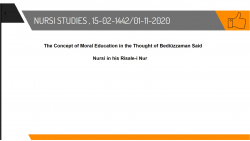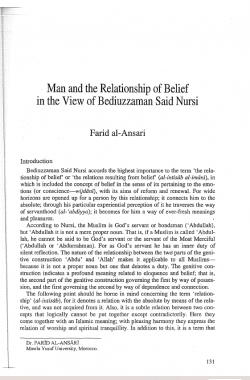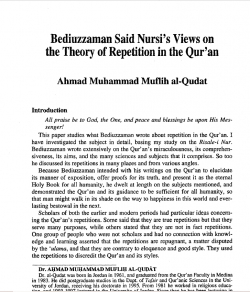Ph.D. Thesis - Doktora Tezi RHETORICAL SITUATION, RHETORICAL APPEALS AND CONCEPTUAL METAPHORS IN NURSI’S DAMASCUS SERMON

Book Stores
Type
E-Book
Authors
ABDULLAH ( Nur Sakinah Thomas Binti )
Category
Ph.D. Thesis - Doktora Tezi
[ Browse Items ]
Publication Year
2017
Publisher
Universiti Putra Malaysia, Malaysia
Tags
Series Name
Abstract
Classical rhetoric which originated from the times of ancient scholars has now
developed rapidly in discourse analysis. However, how rhetoric has managed to
reveal the persuasive language in sermons is still in the motion of research.
There is also limited attention on language and persuasion especially on Muslim
thinkers. Bediuzzaman Said Nursi (1877-1960) was a prominent Muslim
theologian and thinker of the late Ottoman and Modern Turkey whose writings
are considered as influential, but studies on Nursi’s persuasive strategies are
scarce. Therefore, this study attempts to explain the persuasive strategies used
by Nursi in one of his writings which is Damascus Sermon (1911) delivered in
the historic Umayyad Mosque in Damascus, Syria. More specifically, the
objective of the current study is to analyse the rhetorical situation in reference to
lexical signals, the rhetorical appeals and the conceptual metaphors used by
Nursi as persuasive strategies. The interrelatedness of the rhetorical situation,
rhetorical appeals and conceptual metaphors that effect persuasion is also
analysed. A qualitative research method following an explanatory case study
design based on Kinneavy's (1971) theory of discourse was used to analyse the
Sermon. ATLAS.ti 7 was used for coding and categorising the data in this study.
The theoretical perspectives include Bitzer's (1980) rhetorical situation
consisting of exigence, audience and constraints; rhetorical appeals on ethical
appeals (ethos), emotional appeals (pathos) and logical appeals (logos) based
on classical rhetoric. Hoey's (2013) Problem-Solution pattern was used to
analyse the lexical signals and Martin's (2000) inscribed and evoked appraisals
were used to evaluate the pattern. Lakoff and Johnson's (2008) Conceptual
Metaphor Theory was used to interpret the metaphorical linguistic expressions.
The results revealed how persuasion was achieved by Nursi through the mode
of thoughts and actions inherent in his language which created the driving force
behind a mass of followers. They also revealed the recycling Problem-Solution
pattern in the structure of the Sermon’s rhetorical situation, the effectiveness of
Nursi’s interrelated rhetorical appeals and the conceptualisation of metaphors
such as life, despair and love. The results showed that the awareness of the
rhetorical situation, the inscribed and evoked appraisals, the correlated rhetorical appeals and the metaphorical linguistic expressions from the
conceptual metaphors interrelated effectively as Nursi’s persuasive strategies.
Eventually, the findings showed the positive modification and Positive Evaluation
in the Sermon are related to Nursi’s life-long principle of ‘positive action’ that
reveals the themes of belief and freedom which convey the message of universal
peace. These findings are expected to have implications for orators, educators,
administrators, authors and experts in influencing their audience through
persuasive strategies. Although this study has limitations as the focus is on
rhetorical situation, lexical signals, invention and conceptual metaphors of a
translated sermon, the findings are expected to help researchers in the areas of
rhetoric and language studies. This study has theoretical contributions as the
integrated theories and model from the rhetorical, linguistic and metaphorical
perspectives used in analysing the Sermon can benefit orators and other
researchers who are analysing sermons and other similar discourses.
developed rapidly in discourse analysis. However, how rhetoric has managed to
reveal the persuasive language in sermons is still in the motion of research.
There is also limited attention on language and persuasion especially on Muslim
thinkers. Bediuzzaman Said Nursi (1877-1960) was a prominent Muslim
theologian and thinker of the late Ottoman and Modern Turkey whose writings
are considered as influential, but studies on Nursi’s persuasive strategies are
scarce. Therefore, this study attempts to explain the persuasive strategies used
by Nursi in one of his writings which is Damascus Sermon (1911) delivered in
the historic Umayyad Mosque in Damascus, Syria. More specifically, the
objective of the current study is to analyse the rhetorical situation in reference to
lexical signals, the rhetorical appeals and the conceptual metaphors used by
Nursi as persuasive strategies. The interrelatedness of the rhetorical situation,
rhetorical appeals and conceptual metaphors that effect persuasion is also
analysed. A qualitative research method following an explanatory case study
design based on Kinneavy's (1971) theory of discourse was used to analyse the
Sermon. ATLAS.ti 7 was used for coding and categorising the data in this study.
The theoretical perspectives include Bitzer's (1980) rhetorical situation
consisting of exigence, audience and constraints; rhetorical appeals on ethical
appeals (ethos), emotional appeals (pathos) and logical appeals (logos) based
on classical rhetoric. Hoey's (2013) Problem-Solution pattern was used to
analyse the lexical signals and Martin's (2000) inscribed and evoked appraisals
were used to evaluate the pattern. Lakoff and Johnson's (2008) Conceptual
Metaphor Theory was used to interpret the metaphorical linguistic expressions.
The results revealed how persuasion was achieved by Nursi through the mode
of thoughts and actions inherent in his language which created the driving force
behind a mass of followers. They also revealed the recycling Problem-Solution
pattern in the structure of the Sermon’s rhetorical situation, the effectiveness of
Nursi’s interrelated rhetorical appeals and the conceptualisation of metaphors
such as life, despair and love. The results showed that the awareness of the
rhetorical situation, the inscribed and evoked appraisals, the correlated rhetorical appeals and the metaphorical linguistic expressions from the
conceptual metaphors interrelated effectively as Nursi’s persuasive strategies.
Eventually, the findings showed the positive modification and Positive Evaluation
in the Sermon are related to Nursi’s life-long principle of ‘positive action’ that
reveals the themes of belief and freedom which convey the message of universal
peace. These findings are expected to have implications for orators, educators,
administrators, authors and experts in influencing their audience through
persuasive strategies. Although this study has limitations as the focus is on
rhetorical situation, lexical signals, invention and conceptual metaphors of a
translated sermon, the findings are expected to help researchers in the areas of
rhetoric and language studies. This study has theoretical contributions as the
integrated theories and model from the rhetorical, linguistic and metaphorical
perspectives used in analysing the Sermon can benefit orators and other
researchers who are analysing sermons and other similar discourses.
Number of Copies
1
| Library | Accession No | Call No | Copy No | Edition | Location | Availability |
|---|---|---|---|---|---|---|
| Main | 190 | 1 | Yes |




